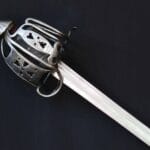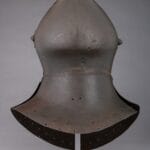Embark on a journey through time as we explore the captivating story of the basket-hilted broadsword. This innovative weapon significantly impacted military history and continues to fascinate historians and collectors alike. From its development to its cultural significance, we’ll uncover the intriguing tale of this iconic sword.
The Rise of the Basket Hilt: A Legacy Forged in Steel
The basket-hilted broadsword, essentially a sword with integrated hand protection, likely emerged in the 16th century. This innovation marked a pivotal moment in sword design, offering unprecedented defense and transforming combat techniques. Its development was a gradual process, evolving from simpler cross-guarded swords as the need for better protection against increasingly sophisticated attacks grew. An early example of a basket hilt was even discovered on the wreck of the Mary Rose, a ship that sank in 1545, suggesting the design was already in use by that time. For armor enthusiasts interested in the evolution of protective gear, our page on the bascinet provides a fascinating look at another important piece of medieval equipment.
The basket hilt itself is a marvel of metalwork—an intricate arrangement of bars, plates, and a knuckle bow that enveloped the hand, forming a protective cage. This ingenious design offered unparalleled defense against both cuts and thrusts, significantly improving a swordsman’s chances of survival. Regional variations emerged, showcasing the interplay of practical needs and cultural aesthetics. The Italian Schiavona, for instance, featured distinctive finger rings, while the Scottish Highlands developed their own iconic basket-hilted broadsword. These variations underscore how diverse needs and regional craftsmanship shaped the weapon’s evolution. For those intrigued by the craftsmanship of sword hilts, our article on the basket hilt sword offers a detailed exploration of its design and historical significance.
The basket hilt didn’t just protect the hand; it subtly altered the very nature of swordsmanship. The enhanced security it provided allowed for new parrying techniques and guards, bolstering both defensive and offensive capabilities. The evolution of swordsmanship can be traced alongside the development of the basket hilt, offering a glimpse into the biomechanics and tactics of close-quarters combat centuries ago. It was a delicate balance of brute strength, strategy, and finely honed skill.
The basket-hilted broadsword played a significant role in European military history, especially in Scotland. There, it transitioned from a mere weapon to a potent symbol of martial heritage and national identity, particularly during the tumultuous Jacobite uprisings. Interestingly, following the defeat of the Jacobite cause, the broadsword was temporarily banned, only to be later adopted by Highland regiments in the British Army, demonstrating its enduring appeal and practicality.
Beyond their battlefield roles, these swords were often exquisite works of art, meticulously crafted by skilled blacksmiths. Today, these historical artifacts are highly prized by collectors. However, this popularity has unfortunately led to a rise in forgeries, emphasizing the need for careful authentication. Owning a genuine basket-hilted broadsword is akin to possessing a tangible piece of history, a responsibility that requires careful preservation for future generations.
Our current understanding of the basket-hilted broadsword continues to evolve as ongoing research reveals new insights. Some experts believe certain design features may have been more symbolic than practical, while others are exploring the social and economic factors that influenced its widespread adoption. This active field of study holds the promise of future discoveries that will further enrich our understanding of this iconic weapon.
Decoding the Basket Hilt: Name, Variations, and Misconceptions
Let’s delve deeper into the terminology surrounding this fascinating weapon. The term “basket hilt” refers to the protective guard, not a specific type of sword. It’s a descriptive term, much like “four-door” for a car – it describes a feature, not the entire object. The basket hilt itself typically consists of interwoven metal strips, plates, and a knuckle bow creating a cage-like structure around the hand.
Basket hilts emerged around the 16th century, evolving from simpler guard designs. Their popularity soared in the 17th and 18th centuries, becoming prevalent on battlefields and favored by certain warrior groups, most famously the Scottish Highlanders with their broadswords (also known as claidheamh mòr in Gaelic). This innovative guard provided crucial protection in the chaotic melee of close-quarters combat.
Several misconceptions surround basket-hilted swords. The name “Andrea Ferrara,” often associated with these weapons, particularly in Scotland, is a prime example. While Andrea Ferrara was a historical figure—a renowned bladesmith—his name became synonymous with quality swords in general, not specifically basket-hilted ones. Similarly, the term “claymore” is frequently misused to denote any Scottish sword. True claymores (claidheamh mòr) were historically large, two-handed swords. The single-handed, basket-hilted broadsword is sometimes called a “claybeg” (claidheamh beag, “small sword”), but this term’s historical accuracy is debated.
Basket hilts weren’t unique to Scotland. They appeared across Europe, each region developing unique variations. This diversity resulted in a fascinating array of designs, each reflecting regional fighting styles, cultural preferences, and available resources.
Key Takeaways:
- Basket Hilt: A Guard, Not a Sword Type: It’s a feature, not a specific weapon.
- Origins: 16th century, evolving from earlier guards.
- Scottish Connection: Strongly associated with Highland warriors but not exclusively Scottish.
- “Andrea Ferrara”: A mark of quality, not a specific sword type.
- “Claymore” vs. “Claybeg”: “Claymore” traditionally refers to a two-handed sword. “Claybeg” is less established historically.
- European Variations: Found across Europe with regional adaptations.
- Enduring Legacy: Remains popular with collectors and history enthusiasts.
Rapier vs. Basket-Hilted Sword: A Clash of Styles
Let’s dissect the differences between two iconic sword types: the rapier and the basket-hilted sword. While both served defensive and offensive purposes, their designs, fighting styles, and historical contexts differ significantly.
The rapier, a symbol of elegance and precision, features a long, slender, sharply pointed blade optimized for thrusting. Its hilt, though often intricate and artistic, prioritizes deflecting an opponent’s blade and protecting the hand with rings and bars. Rapiers were more frequently carried by civilians, particularly wealthy gentlemen, for dueling and self-defense.
The basket-hilted sword, on the other hand, emphasizes robustness and practicality. Its defining feature is the protective “basket” or “cage” surrounding the hand, sometimes extending to protect the wrist. This sturdy guard, paired with a broader, heavier blade, offered excellent protection against cuts and thrusts. Basket-hilted swords were popular among soldiers and civilians seeking a versatile weapon for both cutting and thrusting.
| Feature | Rapier | Basket-Hilted Sword |
|---|---|---|
| Blade | Long, slender, pointed | Broader, heavier |
| Hilt | Rings, bars | Basket-shaped guard |
| Purpose | Thrusting, dueling | Cutting, thrusting |
| Typical User | Civilian | Military, Civilian |
It’s important to note that generalizations have exceptions. Some rapiers had broader blades for cutting, while some basket-hilted swords were surprisingly light. Sword designs also evolved over time. There was even an overlap in hilt designs with the advent of “basket-hilted rapiers” combining a rapier blade with the protective basket hilt. Further research continues to refine our understanding of these complexities.
Unraveling the “Scottish Broadsword”: Claymore, Claidheamh Mòr, and Basket Hilts
The term “Scottish broadsword” often conjures images of a basket-hilted weapon, frequently and mistakenly called a “claymore.” Although the Gaelic word claidheamh mòr does mean “great sword,” it historically refers to two distinct weapons: the two-handed greatsword of the late medieval period, and the later, single-handed basket-hilted broadsword.
The iconic single-handed basket-hilted broadsword gained prominence during the Jacobite uprisings. Its distinctive hilt provided unparalleled hand protection in the chaotic fray of battle. Although often attributed to “Andrea Ferrara,” this name likely denotes a high-quality blade rather than a specific maker or type.
One theory suggests that the basket-hilt design originated in Ireland, brought to Scotland by mercenaries, and later refined by Scottish swordsmiths. The term “broadsword” itself arose in the 17th-18th centuries to distinguish these larger cut-and-thrust swords from slimmer smallswords. “Claybeg” (claidheamh beag, “small sword”) is sometimes used for the single-handed variant, but its historical accuracy remains debated.
| Term | Actual Sword Type | Description |
|---|---|---|
| Claymore | Two-Handed Greatsword | Larger, older sword; not the iconic basket-hilted version |
| Claidheamh Mòr | Both types | Gaelic for “great sword,” applies to both |
| Andrea Ferrara | High-quality blade | Often (but not always) a basket-hilted broadsword |
The world of Scottish swords is complex and filled with nuances. Ongoing research continues to unravel the intricacies of their history, terminology, and cultural significance.
- Jerry McSorley’s Post-Divorce Life: New Beginnings - July 16, 2025
- The Rise and Fall of the New Haven Nighthawks: A Minor League Hockey Legacy - July 16, 2025
- Unlock Jerry McSorley’s Career Highlights: Eye Tax Inc.’s Solar Success - July 16, 2025
















